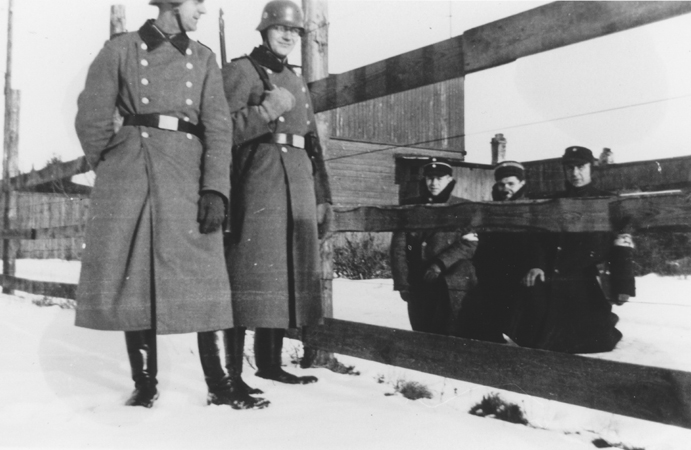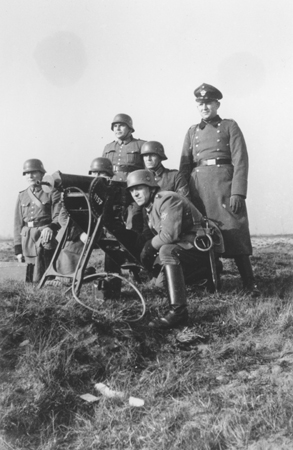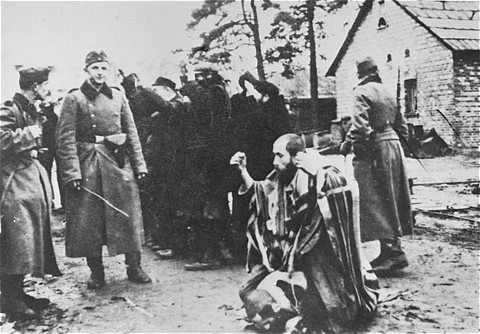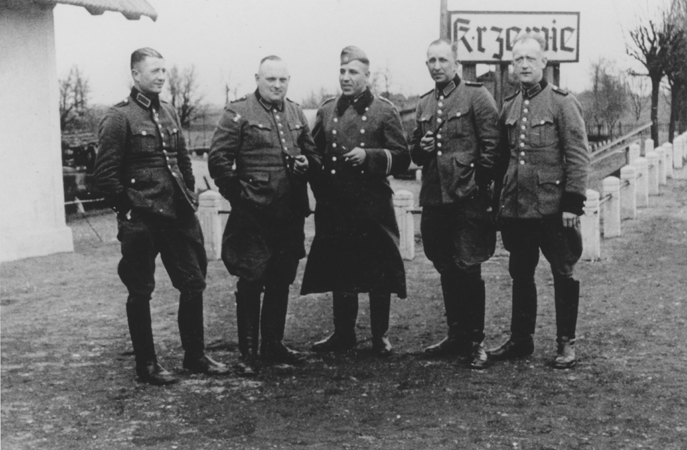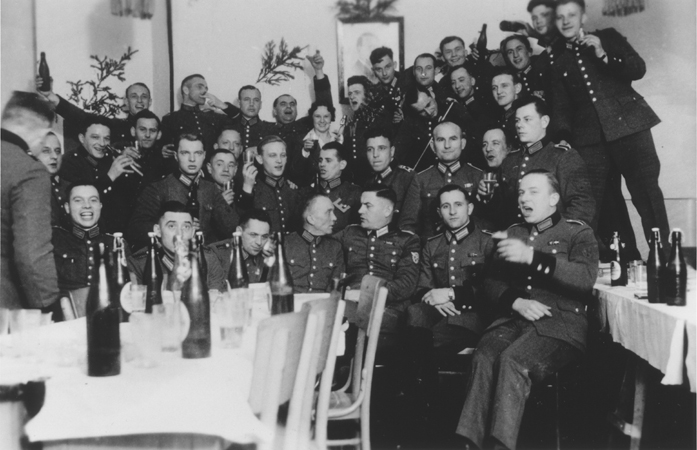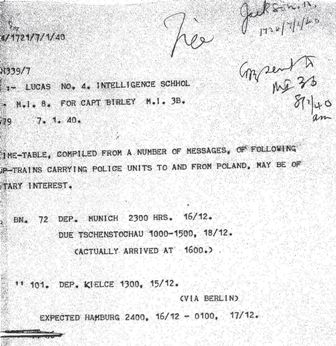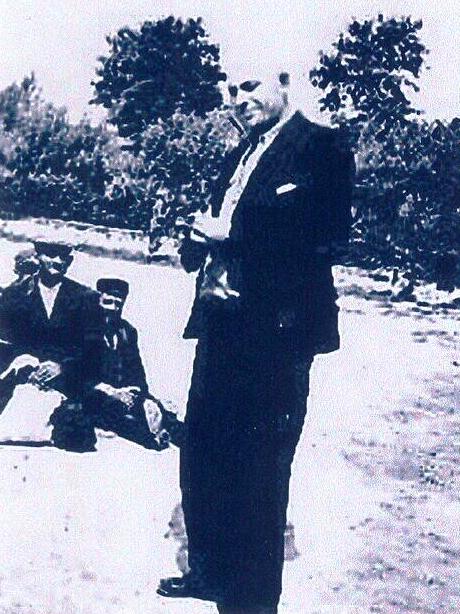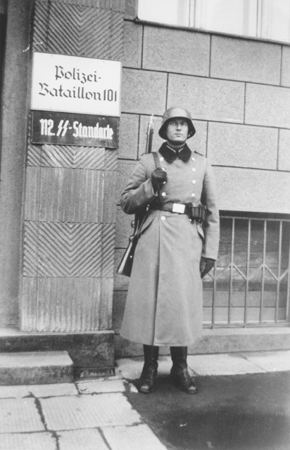Holocaust Education & Archive Research Team |
|
Einsatzgrϋppen
Einsatz Group A Einsatz Group B Einsatz Group C Einsatz Group D Babi Yar Articles Einsatz Leaders Einsatzgruppen Operational Situational Reports [ OSR's #8 - #195 ]
| |||||
Police Battalion 101 in Poland
When Germany invaded Poland in September 1939 Police Battalion 101 based in Hamburg was one of the initial battalions attached to a German army group and sent to Poland.
Crossing the border from Oppeln in Silesia, the battalion passed through Czestochowa to the Polish city of Kielce.
There it was involved in rounding up Polish soldiers and military equipment behind the front lines and guarding a prisoner of war camp.
On 17 December 1939 the battalion returned to Hamburg, where about a hundred of its career policemen were transferred to form additional units. They were replaced by middle-aged reservists drafted in autumn 1939.
In May 1940 after a period of training, the battalion was dispatched from Hamburg to the Warthegau, one of the four regions in western Poland annexed to the Third Reich as the incorporated territories.
Stationed first in Poznan (Posen) until late June and then Lodz – renamed Litzmannstadt by the Germans. The Police Battalion carried out “resettlement actions” for a period of five months, this was part of the Germans plan to “germanise” these newly annexed regions, with racially pure Germans, and to expel Jews and Gypsies into the General Gouvernement
In all the battalion evacuated 36,972 people out of the targeted 58,628. About 22,000 people escaped the evacuations by fleeing. Following its five month resettlement campaign, the battalion carried out pacification actions combing villages and woods and they caught 750 Poles who had evaded earlier evacuations.
On 28 November 1940 the battalion took up guard duty around the Lodz ghetto, which had been sealed seven months earlier, at the end of April 1940, when 160,000 Jews of Lodz were cut off from the rest of the city, by a barbed wire fence.
Guarding the ghetto now became the major duty of Police Battalion 101, which had a standing order to shoot “without further ado” any Jew who ignored the posted warnings and came too close to the fence. This order was obeyed.
In May 1941 the battalion returned to Hamburg and was practically dissolved.
During the next year from May 1941 to June 1942, the battalion was reformed and underwent extensive training and the most notable event was the deportation of Hamburg Jews that the battalion took part in.
From mid-October 1941 to late February 1942 – 59 transports carried more than 53,000 Jews and 5,000 Gypsies from the Third Reich to the east.
East being Lodz, Riga, Kovno and Minsk, all of the transports to Kovno and the first transport to Riga were massacred on their arrival. In June 1942, Reserve Battalion 101 was assigned another tour of duty in Poland.
The battalion was divided into three companies each of approximately 140 men when at full strength. Two companies were commanded by police captains, the third by the senior reserve lieutenant in the battalion.
Each company was divided into three platoons, two of them commanded by reserve lieutenants and the third by the platoon’s senior sergeant.
Each platoon was divided into four squads, commanded by a sergeant or corporal. The men were equipped with carbines, the non –commissioned officers with sub-machine guns.
Each company also had a heavy-machine gun detachment. Apart from the three companies, there was the personnel of the battalion staff, which included, in addition to the five administrative officials, a doctor and his aide, as well as various drivers, clerks, and communication specialists.
The battalion was commanded by fifty-three year old Major Wilhelm Trapp, a World War One veteran and recipient of the Iron Cross First Class.
After the war he became a career policeman, and rose through the ranks. Two captains, both young SS men in their late twenties also played a significant role in the murder actions in Poland, Wolfgang Hoffmann, born in 1914 and Julius Wohlauf born in 1913, who even took his pregnant wife to witness the brutal expulsion of the Jews of Miedzyrzec in late August 1942.
Other notable officers serving in Police Batallion 101 were Hartwig Gnade, Paul Brand, Heinz Buchmann, Oscar Peters, Walter Hoppner, Hans Scheer, and Kurt Drucker.
On 20 June 1942 the battalion received orders for a “special action” in Poland and left for Poland from the Sternschanze station, and the battalion arrived in the Polish town of Zamosc, and five days later the battalion headquarters was moved to Bilgoraj.
The battalion was reassembled in Bilgoraj on 12 July 1942 where Trapp informed the First and Second Company commanders Captain Wohlauf and Lieutenant Gnade of the next days task.
The truck convoy departed from Bilgoraj around 0200 hours on the 13 July 1942 arriving in Jozefow just as the sky was beginning to lighten.
The village was surrounded and the Jews were rounded up and taken to the marketplace, those too frail to walk to the marketplace, as well as infants were shot on the spot.
The Jews assembled in the market place were taken in the battalion trucks to the forest, whilst Trapp made his headquarters in a schoolroom.
Two firing squads carried out the grisly task of executing the Jews of Jozefow all day, in the forest, when darkness finally fell about 9.00pm – the last of the Jews were killed, and the policemen reassembled at the marketplace, and then returned in trucks to Bilgoraj.
An estimated 1500 Jewish men, women and children were killed in Jozefow on 13 July 1942.
In early August 1942 one squad of Third Platoon, was stationed in Lomazy under Sergeant Heinrich Berkemeier.
On 16 August 1942 one day before the impending action, Heinrich Berkemeier in Lomazy received a telephone call from Lieutenant Gnade, informing him that there would be a Jewish “resettlement” the next morning and his men were to be ready at 0400 hours.
The Jewish quarter was cleared and the Jews were assembled in the schoolyard, which quickly filled and the Jews were accommodated in an adjoining sportsfield.
The 1700 Jews of Lomazy were then forced to sit and wait, whilst a group of sixty to seventy Jews were selected to dig mass graves in a nearby forest.
A contingent of fifty Trawniki – SS marched into Lomazy to carry out the shooting, led by an SS officer, and immediately started to eat some food, and drink vodka.
As the grave digging neared completion and after the Trawniki –SS had finished their meals, the one-kilometer march to the forest Some policemen rode in farmers wagons to the forest, where they set up a new cordon.
Others began to march the Jews in groups of 200 or 300 at a time – those who collapsed on the way were simply shot.
As the columns of marching Jews reached the forest, they were separated by sex and sent to one of three collecting areas. Here they were ordered to undress.
Women were allowed to keep their shifts – in some areas the men were totally naked, in others they were allowed to keep their underpants
The Jews approached with their bundles of clothing, which were laid on a pile and searched. After depositing their valuables in a large container or throwing them onto an open blanket, the Jews were made to lie face down for hours.
When preparations for the shooting were complete Gnade began to chase Jews from the undressing areas to the grave.
In small groups the Jews were forced to run between a thin cordon of guards some thirty to fifty meters from the undressing areas to the grave. The grave itself had mounds of dirt piled high on three sides – the fourth side was an incline down which the Jews were driven.
In their state of intoxicated excitement the Trawniki-SS initially began shooting the Jews at the entry to the grave. As a result, the Jews killed first blocked the slope. Thus some Jews went into the grave and pulled the corpses away from the entry.
Immediately large numbers of Jews were driven into the grave, and the Trawniki-SS took up their positions on the walls that had been built up. From there they shot the victims. As the shooting continued the grave began to fill.
The Jews who followed had to climb on and later even clamber over those shot earlier, because the grave was filled with corpses almost to the edge.
The Trawniki-SS often with bottle in hand, as well as Gnade and the SS officer became increasingly drunk, the Trawniki- SS climbed into the grave to shoot the Jewish victims.
The shooting was finished around 7pm, and work Jews who had been spared covered the grave, then the work Jews were then shot as well.
1,700 Lomazy Jews were murdered on 17 August 1942. One of the biggest actions that the Reserve Police Battalion 101 took part in next was the deportation of 11,000 Jews from Miedzyrzec to the Treblinka death camp on 25-26 August 1942.
This was part of the Aktion Reinhard programme of mass murder for the Jews of Poland which was the responsibility of Odilo Globocnik, the SS and Police Leader for Lublin.
The Jews of Miedzyrzec were driven by Trawniki- SS and policemen to the marketplace, and after waiting for hours in the hot August sun, were marched to the train station.
The entire force of Trawniki- SS and policemen was employed to drive the thousands of Jews along the route. Once again shooting was commonplace. Those Jews who could go no further were shot and left lying on the side of the road. Corpses lined the street on the road to the train station.
One final horror was reserved for the end, the train cars had to be loaded – as the Trawniki – SS and Security Police packed 120 to 140 Jews in each car, the reserve policemen stood guard and observed.
An eyewitness remembered the scene:
“When it didn’t go well, they made use of riding whips and guns. The loading was simply frightful. There was an unearthly cry from these poor people because ten or twenty cars were being loaded simultaneously. The entire freight train was dreadfully long. One could not see all of it. It may have been fifty to sixty cars, if not more.
After a car was loaded, the doors were closed and nailed shut.”
The Reserve Police Battalion 101 were involved in more mass shootings in September 1942 in the village of Serokomla, where some 200-300 Jews were shot in gravel pits
In early September 1942 the disposition of the Order Police in the Lublin district was modified. A fourth security zone was created which included the three counties Biala Podlaska, Hrubieszow, and Chelm . This permitted the of the First and Second Platoons of Gnade’s Second Company from the county of Biala Podlaska to the towns of Miedzyrzec and Komarowka in Northern Radzyn county.
In the last week of September most of the remaining Jews in Biala Podlaska were rounded up and transferred to the now nearly empty ghetto of Miedzyrzec.
The Miedzyrzec “transit ghetto” was also re-stocked in September and October from town in the county of Radzyn, directly from Komarowka as well as from Wohyn and Czemierniki via Parczew.
The deportations to Treblinka resumed on 1 October 1942 when 2,000 Jews were shipped from the ghetto of Radzyn, with deportations from Lukow on 8 October 1942.
On the 6 October 1942 after the cattle cars had been loaded – about 150 Jews remained, mostly women and children but some men also. The Jews were brought in groups of twenty, men first then women and children to the cemetery to be shot.
They were forced to lie face down near the cemetery wall and were then shot from behind in the neck. Each policeman fired seven or eight times. At the cemetery gates one Jew sprang at Lieutenant Kurt Drucker with a syringe but was quickly subdued. The other Jews sat quietly awaiting their fate, even after the shooting began. They were quite emaciated and looked half-starved to death, one guard remembered.
Deportation actions followed in Miedzyrzec to Treblinka, and following the deportations on 27 October and 7 November it was cleared of nearly all but some 1,000 work- Jews.
Gnade was now totally in charge and he introduced one further step in the deportation procedure – the strip search. After being assembled in the marketplace, the deportees were driven into two barracks where they were forced to undress and searched for valuables.
They were allowed to only put their underclothes back on and despite the cold weather they were marched, scantily clad to the train station and packed into cattle cars destined for Treblinka death camp.
Miedzyrzec which was difficult to pronounce, was re-named by the Second Company policemen as “Menschenschreck” translated as “Human horror”, an apt name, given the fact that in total 25,000 Jews had been deported from the city of “human horror” to Treblinka.
Reserve Police Battalion 101 also played a part in the Aktion Erntefest – Harvest Festival in November 1943, where the remaining Jews who worked in various labour camps in the Lublin district were liquidated.
On the evening of 2 November 1943 the SS and Police Leader for Lublin Jakob Sporrenberg, who had succeeded Odilo Globocnik, met with the commanders of various forces. These forces included Waffen-SS units from Krakow and Warsaw, Police Regiment 22 from Krakow, Lublin’s own Police Regiment 25 (including Reserve Police Batalion 101),the Lublin Security Police, as well as the commanders of the camps at Majdanek, Poniatowa and Trawniki and Sporrenberg’s own SSPF staff.
The massive killing operation began the next morning. Members of Reserve Police Battalion participated in virtually every phase of the “Harvest Festival” massacre in Lublin.
Early in the morning of 3 November 1943 they took up their positions, one group from the battalion helped to march Jews from various small labour camps around Lublin to the Majdanek concentration camp several kilometres from the city centre on the main road leading to Zamosc.
The largest contingent of Reserve Police Battalion took up positions five meters apart on both sides of the street that led from the main highway past the commandant’s house to the entrance of the inner camp.
Here they watched as an endless stream of Jews from various work camps in Lublin filed past. Women guards on bicycles escorted 5,000 to 6,000 women prisoners from the “old airport” camp, where they had been employed in the hangers, sorting the clothing from the Jews murdered at the three Aktion Reinhard Camps.
Thus assembled were between 16,500 to 18,000 Jews, who as they passed between the chain of reserve policemen into the camp, music blared from two loudspeaker trucks.
Despite these loudspeaker trucks the sound of steady gunfire could be heard from the camp. The Jews were taken to the last row of barracks, where they undressed. Arms raised, hands clasped behind their necks, totally naked, they were led in groups from the barracks through a hole cut in the fence to the trenches that had been dug behind the camp. This route too was guarded by men from Reserve Police Battalion 101.
Stationed only ten meters from the graves, Heinrich Bocholt of First Company witnessed the killing procedure:
“From my position I could now observe how the Jews were driven naked from the barracks by other members of our battalion……. The shooters of the execution commandos, who sat on the edge of the graves directly in front of me, were members of the SD. Some distance behind each shooter stood several other SD men who constantly kept the magazines of the submachine guns full and handed them to the shooter. A number of such shooters were assigned to each grave. Today I can no longer provide details about the number of graves. It is possible that there were many such graves where shooting took place simultaneously. I definitely remember that the naked Jews were driven directly into the graves and forced to lie down quite precisely on top of those who had been shot before them. The shooter then fired off a burst at these prone victims.
How long the action lasted I can no longer say with certainty. Presumably it lasted the entire day, because I remember that I was relieved once from my post. I can give no details about the number of victims, but there were an awful lot of them.”
On the morning of 4 November 1943 the men of Reserve Battalion 101 travelled the fifty kilometres west from Lublin to Poniatowa.
This time the battalion was not dispersed – the men were stationed either between the undressing barracks and the zigzag graves of the shooting site or at the shooting site itself.
They formed the human cordon through which the 14,000 work Jews of Poniatowa, stark naked and hands behind their necks, marched to their deaths while the loudspeakers once again blared music in a vain attempt to cover up the noise of the shooting.
The closest witness was Martin Detmold - "I myself and my group had guard duty directly in front of the grave. The grave was a big zigzag- shaped series of slit trenches about three meters wide and three to four meters deep.
From my post I could observe how the Jews were forced to undress in the last barracks and surrender all their possessions and were then driven through our cordon and down sloped openings into the trenches. SD men standing at the edge of the trenches drove the Jews onward to the execution sites, where other SD men with sub-machine guns fired from the edge of the trench.
Because I was a group leader and could move about freely, I went once directly to the execution site and saw how the newly arriving Jews had to lie down on those already shot.
They were then likewise shot with bursts from the sub-machine guns. The SD men took care that the Jews were shot in such a way that there were inclines in the pile of corpses enabling the newcomers to lie down on corpses piled as much as three meters high.
The whole business was the most gruesome I had ever seen in my life, because I was frequently able to see that after a burst had been fired the Jews were only wounded and those still living were more or less buried alive beneath the corpses of those shot later, without the wounded being given so-called mercy – shots.
I remember that from out of the pile of corpses the SS-men were cursed by the wounded.”
After their brutal role in the destruction of the Jews in the Lublin area, as the tide of war turned against Germany, Reserve Battalion 101, found itself fighting partisans and armed soldiers.
First Lieutenant Hagen was killed accidentally by police gun-fire, Lieutenant Hartwig Gnade, Walter Hoppner and Oscar Peters fell in action. Lieutenant Kurt Drucker returned to Germany wounded.
Major Trapp returned to Germany in early 1944 but was extradited to Poland in October 1947 where he was tried at Siedlce, along with Buchmann, and Kammer. Trapp was sentenced to death, Buchmann was sentenced to eight years in prison, and Kammer to three.
For Hauptsturmfuhrers Hoffman and Wohlauf they resumed their careers in the police, after Germany’s surrender. The number of Jews murdered in shooting actions by Reserve Police Battalion 101 amounted to approximately 38,000 and the number of Jews deported to the Treblinka death camp was estimated at 45,200.
Sources:
Ordinary Men – Reserve Police Battalion 101 and the Final Solution in Poland by Christopher R Browning published by Harper Collins in 1992 NARA USA National Archives Kew USHMM *photos
Copyright: 2007 SJ & Carmelo Lisciotto H.E.A.R.T
|

